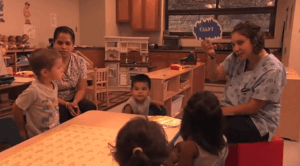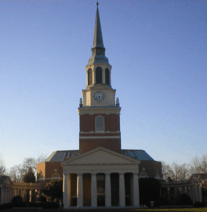Education in North Carolina facts for kids
Education in North Carolina talks about schools and learning in the state, from the very first days when it was a colony all the way up to today. It covers everything from elementary schools to colleges and universities, both public and private.
Contents
History of North Carolina Schools
North Carolina's schools have changed a lot as the state grew from a farming area to a modern place with lots of technology.
In the early days, during the colonial period, most kids learned from private teachers or at schools run by churches. The very first public school in North Carolina opened in New Bern in 1749. It was meant to help poorer families who couldn't pay for school.
As the 1800s went on, public education started to grow. North Carolina set up its first public school system in 1839. However, not all children could go to these schools, especially those in rural areas or African American children.
In the early 1900s, there were big efforts to make schools better. Governor Charles B. Aycock helped improve teacher training, school buildings, and what students learned. This time also saw the start of the North Carolina Community College System.
During the 1950s and 1960s, the Civil Rights Movement brought major changes. Schools became integrated, meaning students of all races could attend the same schools.
Since the 1980s, North Carolina has kept working to make education modern and innovative. There's been a lot of focus on using technology, training teachers, and making sure students are learning well. Programs like "Read to Achieve" were started to help students do better in school.
Early Schools (Before 1900)
In colonial times, education wasn't a top priority. Rich families often hired private teachers for their white children. Some local churches had small schools. A few private academies in towns taught the basics: reading, writing, and arithmetic. Often, one teacher taught all grades (1 to 8) in a single room.
Conditions were still tough in the early 1800s. Textbooks were rare, and homework or exams weren't common. Teachers usually had only a year or two of schooling past 8th grade themselves. Many schools used the "Lancasterian system" where the main teacher taught a few older students, and those students then taught the younger ones, often by having everyone recite lessons together.
By 1852, there were 42 private academies and 30 private colleges, though many colleges didn't last long. There wasn't a statewide public school system yet. The one public university in Chapel Hill was small, with only 230 students in 1850.
Big changes happened in the 1850s thanks to Calvin H. Wiley. As the state superintendent of education from 1853 to 1865, Wiley worked hard to convince people that schooling was important. He helped create the state education association, set up teacher training, and made sure teachers were properly certified. He also pushed for public education for all white children, believing it would help the state's economy.
Wiley's efforts led to growth. From 1853 to 1869, the number of schools grew by 23% to 3,082. Student enrollment went up by 25% to 119,000. The number of licensed teachers tripled, and money spent on public education soared. Enrollment at the university also doubled. Most schools closed during the Civil War (1861-1865) because many teachers and students joined the army.
Schools in the 1900s and 2000s
Compared to other states, North Carolina's schools often ranked lower throughout the 1900s and early 2000s. In 2021, an index called "Chance-for-Success" ranked North Carolina 28th out of 50 states and Washington D.C. This index looks at 13 different things that affect a person's life from childhood to career. In 2014, North Carolina was about average in most areas, but it ranked low (42nd) in school funding. However, it was strong (10th) in "Standards, assessments, and accountability," which means how well schools set goals and check student progress.
Primary and Secondary Education Today

Public elementary and secondary schools in North Carolina are managed by the North Carolina Department of Public Instruction. The North Carolina Superintendent of Public Instruction leads the North Carolina State Board of Education, but the board makes most of the big decisions about public school rules.
North Carolina has 115 public school systems, each run by a local school board. A county might have one or more school systems. The biggest school systems in North Carolina include Wake County Public School System (Raleigh area) and Charlotte-Mecklenburg Schools. In total, there are 2,425 public schools in the state, including over 200 charter schools. Charter schools are public schools that have more freedom in how they operate. North Carolina schools were separated by race until the Brown v. Board of Education court case and the Pearsall Plan helped end segregation.
For a long time, the SAT was the main test students took to get into universities. In 2004, 76% of North Carolina high school students took the SAT. But in 2012, a state law changed, requiring all 11th-grade students to take the ACT. Because students can now take the ACT for free, it has become the most common university entrance exam.
Higher Education in North Carolina
In 1795, North Carolina opened the first public university in the United States. Today, it's known as the University of North Carolina at Chapel Hill. More than 200 years later, the University of North Carolina system includes 16 public universities. Some of these are North Carolina State University, North Carolina A&T State University, North Carolina Central University, East Carolina University, and Appalachian State University. The system also includes one public boarding high school, the North Carolina School of Science and Mathematics.
Besides these universities, North Carolina also has 58 public community colleges in its community college system. Community colleges offer two-year degrees and training programs. The largest university in North Carolina right now is North Carolina State University, with over 34,000 students.
Private Colleges and Universities
North Carolina is also home to many well-known private colleges and universities. These include Duke University, Wake Forest University, Elon University, Davidson College, and High Point University.
One special school is Shaw University, which was the first HBCU (Historically Black College or University) in the Southern United States. Another unique place is the John C. Campbell Folk School, which is the oldest and largest folk school in the United States. It teaches traditional crafts, music, and dance.







